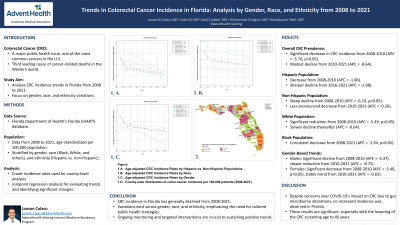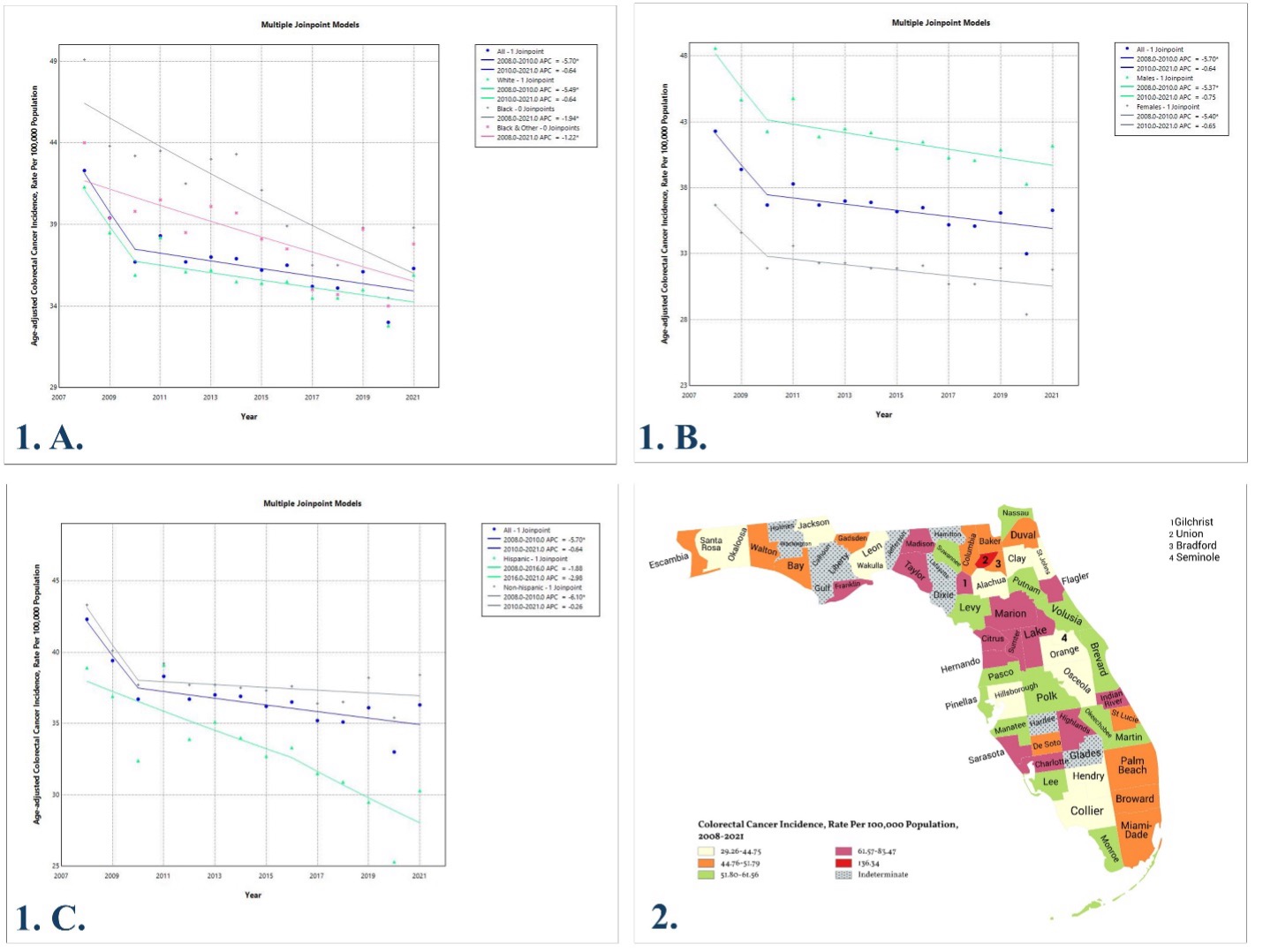Sunday Poster Session
Category: Colon
P0244 - Trends in Colorectal Cancer Incidence in Florida: Analysis by Gender, Race, and Ethnicity from 2008 to 2021
Sunday, October 27, 2024
3:30 PM - 7:00 PM ET
Location: Exhibit Hall E


Lanson Brijesh B. Colaco, MD
AdventHealth
Sebring, FL
Presenting Author(s)
Lanson Brijesh Colaco, MD1, Iktej Jabbal, MD1, Saba Ali, MD2, Muhammad Sohaib Asghar, MD1, Rohin Patel, 3, Deepti Bhandare, MD1, Pankajkumar Patel, MD1
1AdventHealth, Sebring, FL; 2K.V.G. Medical College, Sullia, India, Sebring, FL; 3Columbia University, Sebring, FL
Introduction: Colorectal cancer (CRC) continues to pose a substantial public health challenge, ranking among the most prevalent malignancies in the United States. The COVID-19 pandemic heightened concerns regarding a potential rise in CRC incidence attributed to disruptions in the gut microbiome and the postponement of non-urgent screening colonoscopies. This study seeks to evaluate the incidence rates of CRC in Florida from 2008 to 2021, with particular attention to differences based on gender, race, and ethnicity.
Methods: Data on CRC incidence was sourced from the Florida Department of Health's Florida CHARTS database. We included data from 2008 to 2021, utilizing age-standardized rates per 100,000 population. The dataset was stratified by gender, race (Black, White, and other categories), and ethnicity (Hispanic vs. non-Hispanic). For county-level analysis, crude incidence rates for CRC were compiled across the entire study period. Trends in CRC incidence were assessed using Joinpoint regression analysis.
Results: Joinpoint regression analysis revealed distinct trends in CRC incidence across various demographic groups. In the overall population, there was a significant decrease in CRC incidence from 2008 to 2010 (annual percentage change (APC) = -5.70, p< 0.05), followed by a modest decline from 2010 to 2021 (APC = -0.64). Among the Hispanic population, the incidence decreased from 2008 to 2016 (APC = -1.88), with a sharper decline from 2016 to 2021 (APC = -2.98). The non-Hispanic population experienced a steep decline from 2008 to 2010 (APC = -6.10, p< 0.05), with a less pronounced decrease from 2010 to 2021 (APC = -0.26). The White population saw a significant reduction from 2008 to 2010 (APC = -5.49, p< 0.05), followed by a slower decline after that (APC = -0.64). The Black population consistently decreased from 2008 to 2021 (APC = -1.94, p< 0.05). Gender-based trends indicated that males exhibited a significant decline from 2008 to 2010 (APC = -5.37), with a continued, slower reduction from 2010 to 2021 (APC = -0.75). Females showed a significant decrease from 2008 to 2010 (APC = -5.40, p< 0.05), with a stable trend from 2010 to 2021 (APC = -0.65).
Discussion: Despite concerns regarding a potential increase in CRC incidence post-COVID-19, our analysis indicates that this trend is not evident in the state of Florida. Furthermore, our results provide evidence against the hypothesis that COVID-19 contributes to an overall increase in colon cancer rates.

Disclosures:
Lanson Brijesh Colaco, MD1, Iktej Jabbal, MD1, Saba Ali, MD2, Muhammad Sohaib Asghar, MD1, Rohin Patel, 3, Deepti Bhandare, MD1, Pankajkumar Patel, MD1. P0244 - Trends in Colorectal Cancer Incidence in Florida: Analysis by Gender, Race, and Ethnicity from 2008 to 2021, ACG 2024 Annual Scientific Meeting Abstracts. Philadelphia, PA: American College of Gastroenterology.
1AdventHealth, Sebring, FL; 2K.V.G. Medical College, Sullia, India, Sebring, FL; 3Columbia University, Sebring, FL
Introduction: Colorectal cancer (CRC) continues to pose a substantial public health challenge, ranking among the most prevalent malignancies in the United States. The COVID-19 pandemic heightened concerns regarding a potential rise in CRC incidence attributed to disruptions in the gut microbiome and the postponement of non-urgent screening colonoscopies. This study seeks to evaluate the incidence rates of CRC in Florida from 2008 to 2021, with particular attention to differences based on gender, race, and ethnicity.
Methods: Data on CRC incidence was sourced from the Florida Department of Health's Florida CHARTS database. We included data from 2008 to 2021, utilizing age-standardized rates per 100,000 population. The dataset was stratified by gender, race (Black, White, and other categories), and ethnicity (Hispanic vs. non-Hispanic). For county-level analysis, crude incidence rates for CRC were compiled across the entire study period. Trends in CRC incidence were assessed using Joinpoint regression analysis.
Results: Joinpoint regression analysis revealed distinct trends in CRC incidence across various demographic groups. In the overall population, there was a significant decrease in CRC incidence from 2008 to 2010 (annual percentage change (APC) = -5.70, p< 0.05), followed by a modest decline from 2010 to 2021 (APC = -0.64). Among the Hispanic population, the incidence decreased from 2008 to 2016 (APC = -1.88), with a sharper decline from 2016 to 2021 (APC = -2.98). The non-Hispanic population experienced a steep decline from 2008 to 2010 (APC = -6.10, p< 0.05), with a less pronounced decrease from 2010 to 2021 (APC = -0.26). The White population saw a significant reduction from 2008 to 2010 (APC = -5.49, p< 0.05), followed by a slower decline after that (APC = -0.64). The Black population consistently decreased from 2008 to 2021 (APC = -1.94, p< 0.05). Gender-based trends indicated that males exhibited a significant decline from 2008 to 2010 (APC = -5.37), with a continued, slower reduction from 2010 to 2021 (APC = -0.75). Females showed a significant decrease from 2008 to 2010 (APC = -5.40, p< 0.05), with a stable trend from 2010 to 2021 (APC = -0.65).
Discussion: Despite concerns regarding a potential increase in CRC incidence post-COVID-19, our analysis indicates that this trend is not evident in the state of Florida. Furthermore, our results provide evidence against the hypothesis that COVID-19 contributes to an overall increase in colon cancer rates.

Figure: Figure 1. A. Age-adjusted CRC Incidence Rates by Race
Figure 1. B. Age-adjusted CRC Incidence Rates by Gender.
Figure 1. C. CRC Incidence Rates by Hispanic vs. Non-Hispanic Populations.
Figure 2. County wise distribution of colon cancer incidence per 100,000 patients from 2008-2021.
*Asterisk indicates statistically significant values
*CRC= Colorectal cancer
*APC= Annual percentage change
Figure 1. B. Age-adjusted CRC Incidence Rates by Gender.
Figure 1. C. CRC Incidence Rates by Hispanic vs. Non-Hispanic Populations.
Figure 2. County wise distribution of colon cancer incidence per 100,000 patients from 2008-2021.
*Asterisk indicates statistically significant values
*CRC= Colorectal cancer
*APC= Annual percentage change
Disclosures:
Lanson Brijesh Colaco indicated no relevant financial relationships.
Iktej Jabbal indicated no relevant financial relationships.
Saba Ali indicated no relevant financial relationships.
Muhammad Sohaib Asghar indicated no relevant financial relationships.
Rohin Patel indicated no relevant financial relationships.
Deepti Bhandare indicated no relevant financial relationships.
Pankajkumar Patel indicated no relevant financial relationships.
Lanson Brijesh Colaco, MD1, Iktej Jabbal, MD1, Saba Ali, MD2, Muhammad Sohaib Asghar, MD1, Rohin Patel, 3, Deepti Bhandare, MD1, Pankajkumar Patel, MD1. P0244 - Trends in Colorectal Cancer Incidence in Florida: Analysis by Gender, Race, and Ethnicity from 2008 to 2021, ACG 2024 Annual Scientific Meeting Abstracts. Philadelphia, PA: American College of Gastroenterology.
